Best estate cars 2025
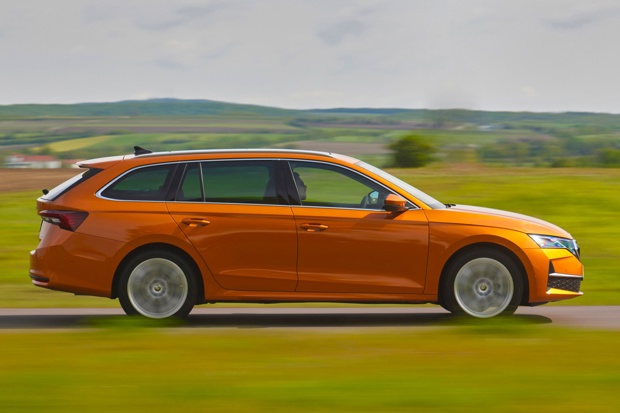
Although the popularity of estate cars has been dented by consumer demand for SUVs of various sizes, savvy car buyers know that traditional wagons still have the edge when it comes to combining comfort, capaciousness and capable handling.
As estates are usually lower to the ground than SUVs, their reduced loading lip height when accessing the cavernous loadspace is most welcome, especially if you're regularly ferrying heavy furniture or dogs around. Plus that lowness usually means estates are more agile to drive as well as being more fuel efficient to boot. Pun intended.
Many SUVs have similar carrying capacities to estates but their volume tends to be more upright, meaning a more traditionally shaped wagon is likely a better solution for swallowing longer loads once you've folded down the rear seats. Trips to Scandi flatpack furniture stores needn't turn into a game of automotive Tetris as you find a space for every box.
While diesels used to be the favoured choice for most wagons, the majority of today's load-luggers are available with different types of hybrid power. Those who want to ditch combustion engines altogether will find there's also a growing number of fully electric estates to choose from.
Read on to find out more about our favourite wagons and discover why these are the best estate cars available to buy new — choose one and your dog will be into it as much as you.
Skoda Octavia Estate
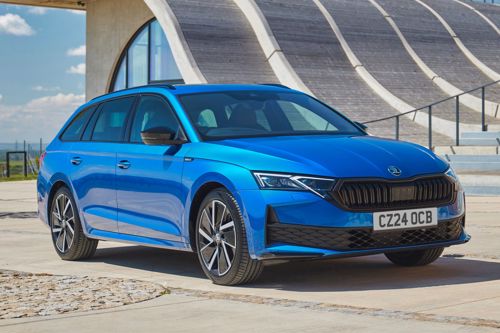
- Boot capacity with rear seats in use — 640 litres
- Boot capacity with rear seats folded — 1700 litres
- Price : maximum boot capacity ratio — £16.96/litre*
For sheer pragmatism, value and all-round ability few cars come close to touching the Skoda Octavia Estate, including the Volkswagen Golf Estate it shares its underpinnings with.
Despite being able to comfortably sit within a typical 4800mm X 2400mm UK parking bay, there's an enormous amount of space inside the Octavia Estate for passengers and their luggage. That practicality can be further amplified by a suite of Skoda's Simply Clever storage solutions, including retaining nets, pop-out hooks and detachable boxes.
Standard equipment's generous right across the range, performance is more than adequate from the choice of petrol and diesel engines — and rapid if you fancy the 265PS Skoda Octavia Estate vRS — yet a real-world 40mpg is the least you can expect to achieve. Right now there're no plug-in hybrid options even though the closely related SEAT Leon Estate can be specced that way. Despite that the Skoda a far more convincing proposition overall.
Toyota Corolla Touring Sports
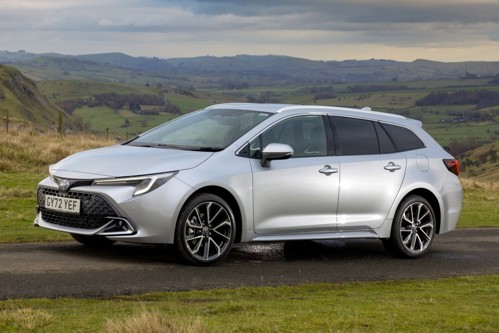
- Boot capacity with rear seats in use — 581-596 litres
- Boot capacity with rear seats folded — 1591-1606 litres
- Price : maximum boot capacity ratio — £20.02/litre*
If you don’t have charging facilities at home but still want to reduce your estate's emissions, then the excellent Toyota Corolla Touring Sports needs to be on your shortlist — even more so now that its rebadged Suzuki Swace clone has been discontinued.
It uses a sophisticated self-charging hybrid drive system that defaults to electric-only mode as often as possible, while also boosting the power of its 1.8- and 2.0-litre petrol engines when accelerating. Whichever you choose this nimble-handling estate's a doddle to drive thanks to its standard automatic transmission and should easily return 50mpg without driving especially carefully.
General levels of kit feature from the entry-level Icon grade upwards plus there's more rear seat room with this estate body than there you'll find in the Toyota Corolla Hatchback thanks to its 60mm longer wheelbase. If you want to maximise the Corolla Touring Sports' load-carrying potential stick to the 1.8-litre engine as it has a 15-litre boot space advantage over 2.0-litre models.
BMW 3 Series Touring
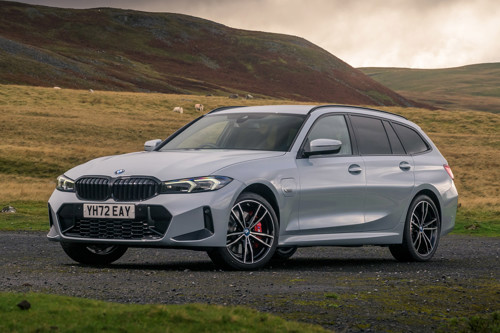
- Boot capacity with rear seats in use — 410-500 litres
- Boot capacity with rear seats folded — 1420-1510 litres
- Price : maximum boot capacity ratio — £29.03/litre*
Despite being far from the most capacious of estates the BMW 3 Series Touring radiates desirability.
BMW's engineers nigh-on fetishise over making their cars handle with impressive agility and its most compact estate's no exception, right from the entry-level 320i Touring onwards. One of its key ingredients is its rear-wheel drive set-up — even the xDrive four-wheel drive systems fitted to the M340i Touring and the monstrously fast BMW M3 Competition Touring is geared to send a greater proportion of power rearwards whenever possible.
Inevitably the requisite mechanical components require accommodation that reduces both boot and rear-seat passenger space — think upon the 3 Series Touring as a generously proportioned four-seater hatchback with an exquisitely finished interior and it makes far more sense.
Diesels no longer feature in the 3 Series range leaving a choice of petrol powerplants with mild and plug-in hybrid electrical amplification. Note that opting for a 330e Touring PHEV, with an electric range of up to 60.3 miles, reduces the BMW's loadspace by 90 litres in order to house its high-voltage battery pack.
Porsche Taycan Sport Turismo
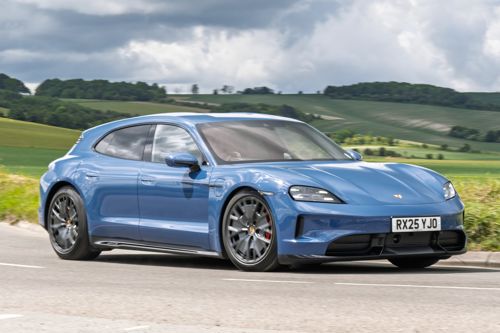
- Boot capacity with rear seats in use — 405-446 litres
- Boot capacity with rear seats folded — 1171-1212 litres
- Front boot or 'frunk' capacity — 81 litres
- Price : maximum boot capacity ratio — £68.99/litre*
Since the demise of the combustion-engined Porsche Panamera Sport Turismo, if you want a more practical performance car from the Stuttgart-based manufacture that isn't an SUV, then the fully electric Taycan Sport Turismo is the way to go.
Okay, many modestly price hatchbacks offer more boot space than you'll find in here, but that rather misses the point. The Sport Turismo's tailgate broadens the line-up's appeal beyond the slinky four-door Porsche Taycan Sport Saloon, meaning it can become a genuine option for admittedly smaller families. Yes, although its interior is beautifully finished and levels of equipment are higher than urban myth would otherwise convince you, there are masses of optional extras to choose from — including a third rear seatbelt...
Those electric power options stretch from a sublime 435PS in the 'standard' Porsche Taycan Sport Turismo to a ridiculous 952PS for the non-turbocharged Turbo S version, although all versions have homologated driving ranges well in excess of 300 miles. Whether you manage that distance while sating your enthusiasm for driving is less likely.
For the largest carrying capacities avoid versions badged GTS or Turbo as they're reduced by 41 litres but in a nod to Porsche traditions, popping the front bonnet reveals a useful 81-litre 'frunk'.
Dacia Jogger
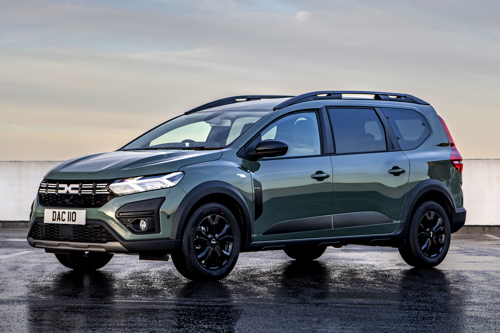
- Boot capacity with second- and third-row seats in use — 160 litres
- Boot capacity with second-row seats in use — 565-696 litres
- Boot capacity with second- and third-row seats folded — 1807 litres
- Price : maximum boot capacity ratio — £10.50/litre*
There's such a degree of genius about the Dacia Jogger that it feels borderline criminal that it doesn't regularly feature in our monthly run-down of the UK's best-selling cars.
Based on the compact and likeable Dacia Sandero Stepway, the Jogger's bodywork is both longer and taller forming a generously sized wagon-shaped rear end. Yet thanks to its rough-and-tumble unpainted plastic body addenda and a third-row of forward-facing seats the boundaries are blurred between estate, SUV and MPV.
Okay, with all seven seats in place the boot capacity's sub-modest at 160 litres but they're simply folded down — or easily removed altogether — when not required. Lower all five rear seats down and there's almost as much space back there as in a studio flat located in one of London's up-and-coming boroughs. Not missing a trick, Dacia will also sell you a range of tailored camping gear to complement your Jogger.
It's an inexpensive car and many parts of its interior don't feel remotely plush, yet it's not remotely cheap or nasty inside either. Power comes via a tiny turbocharged petrol or a non-turbo alternative bolstered by a self-charging hybrid system providing real-world returns of 50mpg without trouble. All this for a smidge over £24k for the most expensive version — seriously, what's stopping you?
Mercedes E-Class Estate
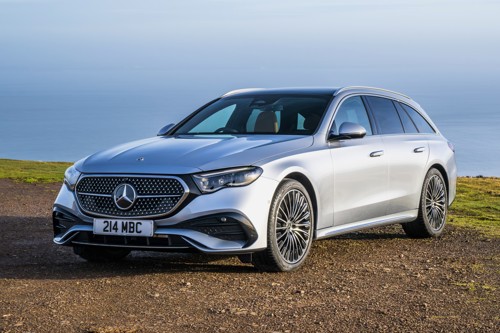
- Boot capacity with rear seats in use — 460-615 litres
- Boot capacity with rear seats folded — 1675-1830 litres
- Price : maximum boot capacity ratio — £32.63/litre*
Few family cars are universally recognised status symbols in the way the Mercedes E-Class Estate and its forebears have been for the past five decades. That three-pointed star still stands for much that people find desirable.
Suitably prestigious and comfortable for its passengers, Merc hasn't overlooked its large wagon's business end with an impressively dimensioned cargo bay that surpasses almost every other estate on sale. That's providing you don't opt for either of the plug-in hybrid versions — the E300e and E300de — which suffer a 55-litre capacity reduction.
That's likely to matter less to company car drivers who are bewitched by the PHEVs' 9% Benefit-in-Kind (BiK) taxation banding as well as their EV driving ranges of over 60 miles. For private buyers the mild hybrid-assisted diesel E220d Estate is the pick of the range — and it comes with maximum boot space.
There's a bewildering assortment of engine and trim level combinations but we reckon the sweetest spots are the sportily styled AMG Line Premium and its trad-look Exclusive Premium alternative. Don't waste time scouring the options list for boot-mounted rear-facing child seats — they've been conspicous by their absense for years.
Performance fans haven't been overlooked, evidenced by the astonishing 3.9-second 0-62mph time of the Mercedes-AMG E53 4Matic+ — it too is PHEV-equipped, reducing its greed for unleaded in the process.
Peugeot E-308 SW
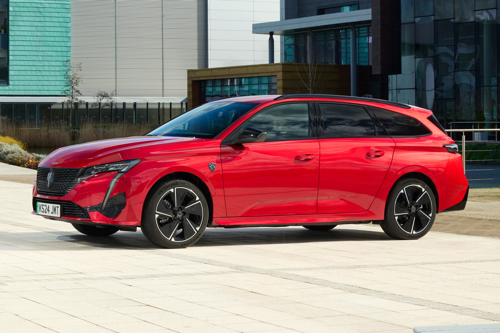
- Boot capacity with rear seats in use — 548 litres
- Boot capacity with rear seats folded — 1574 litres
- Price : maximum boot capacity ratio — £24.82/litre*
Not a comparitive bargain the manner of the discontinued MG 5 EV was yet of the current electrically-powered estate crop, the Peugeot E-308 SW ticks more boxes than most others with its combination of a plushly-appointed passenger cabin and capacious cargo bay in a package that feels price-appropriate.
Similar to the Toyota Corolla Touring Sports, E-308 SW has a longer wheelbase than the Peugeot E-308 Hatch although in this case rear seat room remains unchanged as the additional length is for the benefit of loadspace.
Talking of which, the elephant in the boot here is that this electric version — plug plug-in hybrid versions of the combustion-engined Peugeot 308 SW — are 60 litres less commodious than the diesel- and mild hybrid petrol-powered models.
So why have we favoured the EV version? Chiefly because its smoother drive system amplifies the Peugeot's overall refinement and its WLTP Combined cycle range of up to 254 miles will be more than ample for most drivers' need that majority of the time. That it's also cheaper than most of the PHEV versions helps buyers making the electric switch save even more money.
Volkswagen Passat Estate
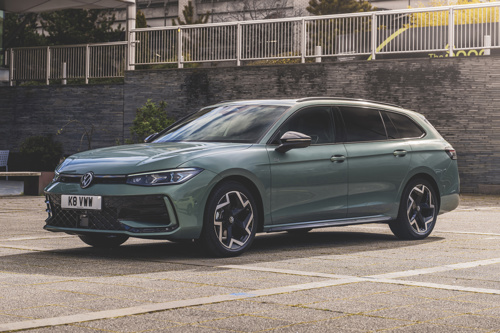
- Boot capacity with rear seats in use — 510-690 litres
- Boot capacity with rear seats folded — 1770-1920 litres
- Price : maximum boot capacity ratio — £20.75/litre*
Choosing whether to include the VW Passat Estate or the incredibly similar Skoda Superb Estate in our list of favourite load-luggers was something we wrangled over for an inordinately long time. So what tipped us to favour the Volkswagen, when it's around £2500 pricier?
Well, given much of their underpinnings and external bodywork is identical, it's no surprise to find that their loadspace volumes also match. Also the same are a trio of the engines, namely the 150PS 1.5-litre mild hybrid petrol, the petrol-only 204PS 2.0-litre and an eHybrid PHEV version of the 1.5, also with 204PS. With a nod to loadspace, be aware that when fitted with the plug-in hybrid kit there's a serious decimation in boot volume to the tune of 180 litres. Ouch.
While the Superb's also available 150PS and 193PS 2.0-litre diesels plus a 265PS editon of the 2.0-litre petrol, the latter two with all-wheel drive, the VW feels more forward-facing by eschewing all of those for a 272PS version of the eHybrid. Given the current taxation system, that might well appeal more to company car drivers than private buyers.
Tipping the scales further the Passat Estate's way is its sleeker, more upmarket feeling interior that feels that bit more special than the Skoda's and more befitting the VW roundel's image. It's an intangible but important factor when the margins are this slender.
Volvo V60

- Boot capacity with rear seats in use — 519 litres
- Boot capacity with rear seats folded — 1821 litres
- Price : maximum boot capacity ratio — £24.13/litre*
In the annals of business case studies you'll read about Heinz's master stroke with its Salad Cream. Sales of said dressing had plummeted as consumers voted with their hard-earned for mayonnaise this and and piri piri that, causing Heinz to announce it was ceasing production. Guess what? There was an outcry and shoppers who'd long turned their backs on the condiment suddenly couldn't get enough of it, generating a Salad Cream demand surge that's still at a level sufficient to warrant its continued production.
What's this got to do with the Volvo V60? Well, a couple of years ago the Swedish brand announced it was withdrawing from selling estates in the UK, also pulling the Volvo V90 at the same time, as Brits much preferred SUVs. Orders were closed but there remained sufficient unsold stock in the system that Volvo's website continued to list them as new and available. And guess what? Okay, not exactly a surge but demand increased to a level that persuaded Volvo to re-open orders again. 'Hurra' as they perhaps say in Stockholm.
Today's V60 range is modest with a trio of engines, none of which are diesel — the mild hybrid B4(P) is accompanied by two plug-in hybrids labelled T6 (350PS) and T8 (455PS), both of which have claimed electric driving ranges north of 50 miles. Unlike its rivals, Volvo cites the same boot space figures for the PHEV-powered V60s as their non-plug-in sibling.
As is the norm for Volvos, the passenger space is exceptionally comfortable, superbly assembled and bristling with the effortless elegance that typifies Scandi design.
Subaru Outback
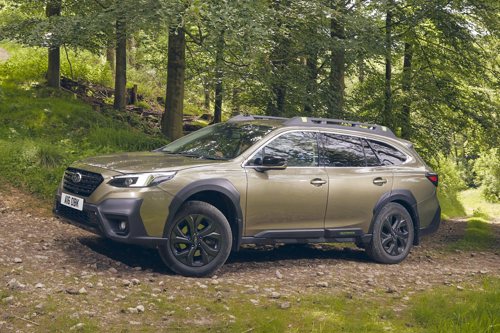
- Boot capacity with rear seats in use — 559 litres
- Boot capacity with rear seats folded — 1848 litres
- Price : maximum boot capacity ratio — £21.91/litre*
Rounding out our favourite 10 estates list is the Subaru Outback which has made the cut as it's the sole survivor on the UK market of a niche that really should have been far more popular than it was.
While the Outback's body and roomy interior is like that of a conventional estate, its elevated ride height gives it increased ground clearance, which when combined with grippier tyres and all-wheel drive result in a car that has more go-anywhere ability than most car buyers need or that most SUVs can actually deliver. If ever there was a type of car befitting of the otherwise meaningless term 'crossover', this is it.
For those people who 'get' this kind of car, the Outback's now your only choice with every alternative, including the Audi A6 Allroad, the Mercedes E-Class All-Terrain and the Volvo V90 Cross Country among many others, long since disappearing from price lists.
With a 2.5-litre non-hybrid petrol as your sole propulsion choice it's not the most cost-effective of estates to run as its 33.0mpg WLTP Combined cycle fuel efficiency figure confirms, but its novel flat-four cylinder configuation and smooth Lineartronic CVT transmission are exactly what Subaru loyalists crave.
If further proof were needed that Subaru knows Outback buyers' wants and needs inside out, its middle-ranking trim level is called Field.
*Price : maximum boot capacity ratio — the quoted price per litre is the on-the-road (OTR) list price of the least expensive model in the range divided by the total boot volume of the most spacious format it's available in. Prices are checked and updated monthly.
What actually is an estate car?
Automotive history is no different to other topics which have been studied and archived in that sometimes the precise origins of a subject weren't actually documented — 'estate car' is such an example.
That said, because it's relatively recent history that was, until recently, still within living memory of experts around at the time, it's been possible to come to the likely source of the term by working backwards in time and using contemporary publications.
The most likely origin of estate car is therefore linked to special-bodied cars commissioned by wealthy land-owners a century ago. They wanted something that was as comfortable as their 'enclosed saloon' car for them and any passengers when venturing into town, yet with an almost van-like rear end to enable large items to be transported easily around their expansive estates.
Today's estates are available at a wide variety of price points, so they're no longer the preserve of the wealthiest people, yet in purpose they remain very similar — a comfortable area for people at the front with an enlarged cargo space behind.
Some of those early, specially commissioned cars were fitted-out with cabinets within their loadspace, usually pupose-designed to house shotguns, rifles and ammunition for game-hunting on the estates. As time progressed they were often based on sports cars rather than comfortable saloons, enabling the hunt to track the game more rapidly — these soon became known as 'shooting brakes', a term still occasionally used by some manufacturers today.
Curiously, the 'brake' aspect isn't related to the car's own mechanical components but from railway brake vans. These were small carriages attached to the back of trains that helped the locomotive at the front in slowing the whole ensemble down more effectively. As brake vans weren't fitted with seats for passengers, they also doubled as space for oversized cargo that was too big for regular carriages, hence the link with shooting brake cars having their heavy goods located at the back out of the way.
On a further related note, the typical name estate cars are given in France in 'break' — whether that's derived from 'brake van' or 'shooting brake' is a debate that keeps automotive historians awake at night.
Why are so many estates not actually called 'estate'?
Despite estates' origins being firmly linked with society's most wealthy people in the early days of motoring, many car buyers regard them as downmarket and crude compared with saloon cars. That was understandable when more affordable versions went on sale in the 1930s because several were essentially van designs with a basic, comfort-free interior rigged-out with additional seats and some roughly installed side windows.
What didn't help was that in Britain, what had become uninspiringly known as 'utility cars' were legally categorised as vans until the 1950s. While that presented cheaper tax advantages they were also seriously hampered by a 30mph maximum speed limit when driven outside urban areas.
In an attempt to make these cars more appealing, many manufacturers gave their estate models euphemistic names to conjure images of, well, anything so long as it didn't sound either basic or van-like, although whether all of the list of monikers shown below were successful is debatable:
- Aerodeck
- Avant
- Belvedere
- Clubman
- Countryman
- Familiale
- MCV
- Multi Wagon
- Panorama
- Safari
- Savanna
- Shooting Brake
- Sport Brake
- Sport Tourer
- SportCross
- Sports Hatch
- Sports Tourer
- Sportswagon
- Sportwagon
- ST
- Station Wagon
- Stretchback
- SW
- Tourer
- Touring
- Touring Sports
- Tourmaster
- Traveller
- T-Series
- Variant
- Vario
- Voyage
- Wagon
- Weekend
Which is the most spacious estate car?
Among our list of the best estate cars on sale, the most spacious model with five seats in use is the Dacia Jogger at 696 litres when its third-row seats have been removed. It's followed by the Volkswagen Passat Estate with 690 litres of space while with 640 litres the Skoda Octavia Estate is third.
Fold all of the rear seats over to maximise the estates' carrying capacity and the order changes considerably with the Passat Estate jumping to the top with 1920 litres. Claiming second place is the 1848 litres of the Subaru Outback with the Mercedes E-Class Estate is third with 1830 litres available.
Can you buy electric estate cars?
Yes you can by estates that are 100% electrically driven although they are regarded by car buyers and manufacturers alike as a niche within a niche right now. While we expect more to become available over the next couple of years, the chances are that there'll always be a broader choice when it comes to electric SUVs.
Electric estate cars currently on sale are:
- Audi A6 Avant e-tron
- BMW i5 Touring
- Peugeot E-308 SW
- Porsche Taycan Sport Turismo
- Porsche Taycan Cross Turismo
- Vauxhall Astra Sports Tourer Electric
- Volkswagen ID.7 Tourer
What's the best estate car for sale right now?

